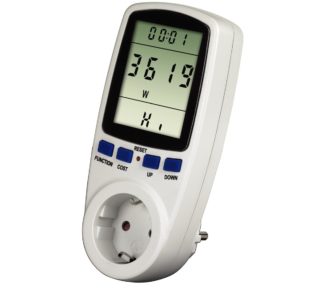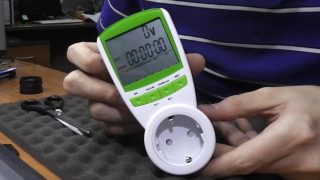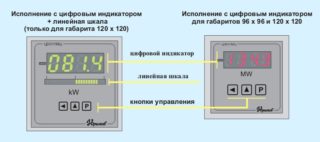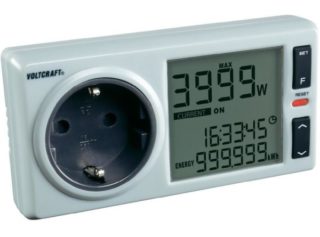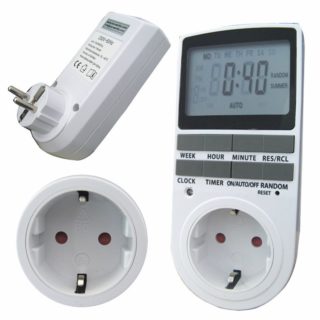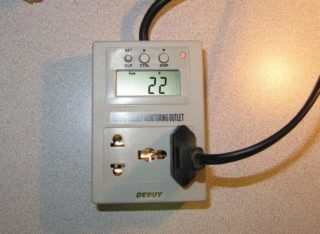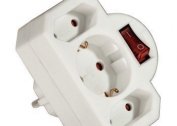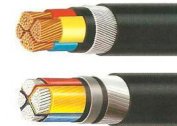According to the energy meter installed in the apartment, it is difficult to determine how much is consumed by a separate device connected to the home network. It is necessary for users to know this value in order to put things in order in the accounting system for consumers who are constantly operating. A portable electronic device that plugs directly into a wall outlet and called a power meter will help solve the problem.
general information
A wattmeter or an electricity meter, an adapter in a socket is a compact independent device designed to measure the power consumed by a specific load. In addition, the following parameters are displayed on the board of modern meters of electricity consumption in the outlet:
- value of the active voltage in the network;
- Estimated time of work for this consumer;
- estimated cost of energy spent over a certain period of time.
The household electricity consumption meter is connected in parallel with the load and therefore takes part of it from the mains.
The magnitude of the power taken by the measuring device is so small that it is not taken into account when calculating the total energy consumption.
A classic wattmeter consists of the following main components:
- current and voltage meters;
- analog-to-digital converter (ADC);
- microcontroller;
- the dial-up field and the indicator necessary for input-output of data.
All these components when working together provide the required functionality of the device for measuring the consumed electrical energy.
Wattmeter working principle
The operation of the device is based on an electronic algorithm for calculating electricity in watts, produced by multiplying the readings of current and voltage meters. Each of them is registered by a separate module, which is part of the device, and then the obtained values are processed in the ADC and multiplied in the appropriate form.
Presentation of information in digital form simplifies all computational operations and allows you to display totals on the display screen.
The microcontroller built into the portable meter controls the operation of all parts of the electronic circuit and provides the following operations:
- measuring the amount consumed per unit time of power (in kilowatts);
- calculation and output to the indicator of the indicator of the current voltage in the network (in Volts);
- indication of current in the load line (in Amperes);
- accounting for the time of continuous operation of the consumer.
Some “advanced” models of power meters provide an approximate estimate of the cost of electrical energy consumed over a certain period of time. Its value is also displayed on the built-in display.
Appearance and characteristics of power meters
Externally, the device for measuring electricity consumption resembles a compact adapter to an outlet, on the front panel of which there is a field with dial buttons and an electronic display. To bring it into working condition, just plug the device into a power outlet and set the current time. Upon completion of these operations, the wattmeter enters the automatic metering mode of electric energy consumption.
Technical characteristics of the electronic device can be represented as follows:
- Supply voltage - 190-270 Volts.
- The maximum power in the load is 3.6 kW.
- Current consumption - up to 16 amperes.
- The discreteness of the power readings is 0.1 watts.
- Measurement accuracy (reading error) - 1%.
- The maximum value of the energy taken into account by the device is up to 10,000 kW / h.
Electricity consumption for own needs does not exceed 0.5 watts, and the temperature range in which the device works satisfactorily is from plus 5 to 40 degrees Celsius.
Pros and Cons of Energy Meters
The advantages of electronic devices such as "sockets electricity meters" include:
- accessibility for any user;
- the ability to evaluate each household appliance in the house by its energy intensity;
- ease of handling.
In addition, according to the indications displayed on the indicator, the user gets a complete picture of the parameters of the current power network.
Based on the data read from the electronic scoreboard, it is possible to estimate the cost of electricity for a fixed period of time.
The disadvantages of devices of this type include:
- the presence of restrictions on the maximum load (not more than 3.6 kW);
- the inability to use the adapter in unheated rooms.
Most samples of electrical appliances connected to the home network fit into the maximum power rating.
Ways of using an electricity meter and operating features
According to the instructions for the use of a compact electric meter, handling it boils down to the following simple operations:
- The meter is plugged in.
- The device under test is connected to the network through it.
- After resetting the initial settings, the information considered by the counter will appear on the screen.
During the operation of the digital device, it is necessary to carefully monitor the serviceability of the outlet, on the quality of the connections of which the efficiency of the electricity meter depends.
After loss of electricity in the network, the product will have to be reinstalled again, since the reading will be interrupted. On some models, these values are stored in the device’s internal memory. If desired, they can be called up to the indicator by dialing on the button field of the corresponding combination (see instructions).
Smart Socket
The first samples of the so-called “smart” or smart sockets appeared at the owners of personal out-of-town households, forced to control the condition of the equipment involved in the house. Modern smart meters, the main function of which is the metering of electricity consumption, allow you to:
- Program the on and off time for household appliances.
- Automatically start important processes even before the owner returns from work, saving on energy consumption.
- Turn off appliances that were left unattended when turned on and protect the home from unauthorized persons.
These devices are used in areas where protection against forgetfulness and taking necessary measures in the absence of the owner is in demand. To do this, they have an option that allows you to control home equipment through a smartphone with a special application installed on it.
Another option for remote control involves sending short SMS messages to a specific number. After sending the appropriate command, the music center or similar equipment automatically turns on, giving the impression of being in the owner’s house. Modern models of household wattmeters represent a further development of the principle of a smart socket, since they have all its signs.
Modern smart wattmeters
The structure of modern intelligent wattmeters installed in the socket includes an electronic module that provides reliable communication with the owner of the house via the Internet. Management is carried out remotely via a mobile smartphone or other device. Due to this, the functionality of smart wattmeters has expanded significantly. With their help, it is possible to remotely disable the equipment operating in the house in case of emergency or emergency situations.
Such devices are widely used in research laboratories engaged in improving the principles of energy conservation.
As an example of an intelligent socket-wattmeter, the TP-Link HS110 model, which is very popular with the consumer, is proposed for consideration. Her work is characterized as follows:
- control and reading of power consumption is possible at a distance;
- remote switching of home consumers of electricity is provided;
- Remote monitoring of energy consumption allows the user to select the optimal heating mode, and also helps to set the desired level of power consumption.
Despite all the advantages of smart energy meters that are plugged into an outlet, they also have certain disadvantages: the high cost of intelligent products and the dependence of their functionality on the reliability of an existing communication channel.
